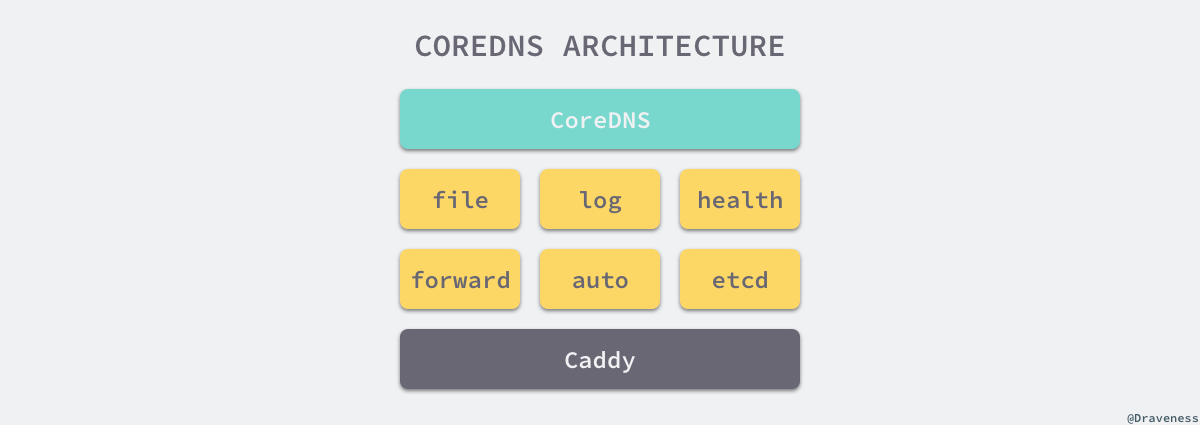架构

搭建
正常使用kubeadm等工具部署的集群中默认都已经部署有coredns,以下为手动部署的流程:
- 创建一个serviceaccount用来做鉴权用
- 创建clusterrole对象system:coredns
- 绑定serviceaccount和clusterrole
- 创建coredns的配置configmap,在后面创建deployment时引用。这里需要注意根据需要修改forward和pods属性
- 创建coredns的deployment,容器引用对应的configmap,限制资源、暴露端口、配置调度策略等到
- 创建service,设置podselector和端口
coredns.yaml
1
2
3
4
5
6
7
8
9
10
11
12
13
14
15
16
17
18
19
20
21
22
23
24
25
26
27
28
29
30
31
32
33
34
35
36
37
38
39
40
41
42
43
44
45
46
47
48
49
50
51
52
53
54
55
56
57
58
59
60
61
62
63
64
65
66
67
68
69
70
71
72
73
74
75
76
77
78
79
80
81
82
83
84
85
86
87
88
89
90
91
92
93
94
95
96
97
98
99
100
101
102
103
104
105
106
107
108
109
110
111
112
113
114
115
116
117
118
119
120
121
122
123
124
125
126
127
128
129
130
131
132
133
134
135
136
137
138
139
140
141
142
143
144
145
146
147
148
149
150
151
152
153
154
155
156
157
158
159
160
161
162
163
164
165
166
167
168
169
170
171
172
173
174
175
176
177
178
179
180
181
182
183
184
185
186
187
188
cat coredns.yaml
apiVersion: v1
kind: ServiceAccount
metadata:
name: coredns
namespace: kube-system
---
apiVersion: rbac.authorization.k8s.io/v1
kind: ClusterRole
metadata:
labels:
kubernetes.io/bootstrapping: rbac-defaults
name: system:coredns
rules:
- apiGroups:
- ""
resources:
- endpoints
- services
- pods
- namespaces
verbs:
- list
- watch
---
apiVersion: rbac.authorization.k8s.io/v1
kind: ClusterRoleBinding
metadata:
annotations:
rbac.authorization.kubernetes.io/autoupdate: "true"
labels:
kubernetes.io/bootstrapping: rbac-defaults
name: system:coredns
roleRef:
apiGroup: rbac.authorization.k8s.io
kind: ClusterRole
name: system:coredns
subjects:
- kind: ServiceAccount
name: coredns
namespace: kube-system
---
apiVersion: v1
kind: ConfigMap
metadata:
name: coredns
namespace: kube-system
data:
Corefile: |
.:53 {
errors
health
kubernetes cluster.local in-addr.arpa ip6.arpa {
pods insecure
fallthrough in-addr.arpa ip6.arpa
}
prometheus :9153
forward . /etc/resolv.conf
cache 30
loop
reload
loadbalance
}
---
apiVersion: apps/v1
kind: Deployment
metadata:
name: coredns
namespace: kube-system
labels:
k8s-app: kube-dns
kubernetes.io/name: "CoreDNS"
spec:
# replicas: not specified here:
# 1. Default is 1.
# 2. Will be tuned in real time if DNS horizontal auto-scaling is turned on.
strategy:
type: RollingUpdate
rollingUpdate:
maxUnavailable: 1
selector:
matchLabels:
k8s-app: kube-dns
template:
metadata:
labels:
k8s-app: kube-dns
spec:
priorityClassName: system-cluster-critical
serviceAccountName: coredns
tolerations:
- key: "CriticalAddonsOnly"
operator: "Exists"
nodeSelector:
kubernetes.io/os: linux
affinity:
podAntiAffinity:
preferredDuringSchedulingIgnoredDuringExecution:
- weight: 100
podAffinityTerm:
labelSelector:
matchExpressions:
- key: k8s-app
operator: In
values: ["kube-dns"]
topologyKey: kubernetes.io/hostname
containers:
- name: coredns
image: coredns/coredns:1.8.0
imagePullPolicy: IfNotPresent
resources:
limits:
memory: 170Mi
requests:
cpu: 100m
memory: 70Mi
args: [ "-conf", "/etc/coredns/Corefile" ]
volumeMounts:
- name: config-volume
mountPath: /etc/coredns
readOnly: true
ports:
- containerPort: 53
name: dns
protocol: UDP
- containerPort: 53
name: dns-tcp
protocol: TCP
- containerPort: 9153
name: metrics
protocol: TCP
securityContext:
allowPrivilegeEscalation: false
capabilities:
add:
- NET_BIND_SERVICE
drop:
- all
readOnlyRootFilesystem: true
livenessProbe:
httpGet:
path: /health
port: 8080
scheme: HTTP
initialDelaySeconds: 60
timeoutSeconds: 5
successThreshold: 1
failureThreshold: 5
readinessProbe:
httpGet:
path: /ready
port: 8181
scheme: HTTP
dnsPolicy: Default
volumes:
- name: config-volume
configMap:
name: coredns
items:
- key: Corefile
path: Corefile
---
apiVersion: v1
kind: Service
metadata:
name: kube-dns
namespace: kube-system
annotations:
prometheus.io/port: "9153"
prometheus.io/scrape: "true"
labels:
k8s-app: kube-dns
kubernetes.io/cluster-service: "true"
kubernetes.io/name: "CoreDNS"
spec:
selector:
k8s-app: kube-dns
clusterIP: CLUSTER_DNS_IP
ports:
- name: dns
port: 53
protocol: UDP
- name: dns-tcp
port: 53
protocol: TCP
- name: metrics
port: 9153
protocol: TCP
创建后:
1
2
3
4
5
6
7
8
9
10
11
12
[root@none-nested-master hujin]# kubectl get service -n kube-system
NAME TYPE CLUSTER-IP EXTERNAL-IP PORT(S) AGE
k8s-keystone-auth-service ClusterIP 10.233.40.69 <none> 8443/TCP 4d20h
kube-dns ClusterIP 10.233.0.110 <none> 53/UDP,53/TCP 7d2h
[root@none-nested-master hujin]# kubectl get deploy -n kube-system
NAME READY UP-TO-DATE AVAILABLE AGE
coredns 1/1 1 1 7d2h
k8s-keystone-auth 1/1 1 1 4d18h
[root@none-nested-master hujin]# kubectl get deploy -n kube-system
NAME READY UP-TO-DATE AVAILABLE AGE
coredns 1/1 1 1 7d2h
k8s-keystone-auth 1/1 1 1 4d18h
修改集群cluster dns配置,这里如果集群默认部署coredns,会设置成pod的ip,修改后,新建的pod中/etc/resolv.conf文件会获取配置后的ip
1
2
3
4
5
vim /etc/kubernetes/kubelet-config.yaml
clusterDNS:
- 10.233.0.110
service kubelet restart
使用
通过使用busybox中的nslookup命令访问域名
1
2
3
4
5
6
7
8
9
10
11
12
13
14
15
cat busybox.yaml
apiVersion: v1
kind: Pod
metadata:
name: busybox2
namespace: default
spec:
containers:
- image: aarch64/busybox
command:
- sleep
- "3600"
imagePullPolicy: IfNotPresent
name: busybox2
restartPolicy: Always
访问service
格式:[svc-name].[namespace].svc.[self-defined cluster domain]
1
2
3
4
5
6
7
8
9
10
11
# 查询域名:
/ # nslookup my-apache.default.svc.cluster.local
Server: 10.233.0.110
Address 1: 10.233.0.110 kube-dns.kube-system.svc.cluster.local
Name: my-apache.default.svc.cluster.local
Address 1: 10.233.4.36 my-apache.default.svc.cluster.local
# 通过域名访问服务
sh-4.2# curl my-apache.default.svc.cluster.local
<html><body><h1>It works!</h1></body></html>
访问pod
格式:[pod-ip].[namespace].pod.[self-defined cluster domain]
1
2
3
4
5
6
7
8
9
10
11
# 查询域名
/ # nslookup 10-233-127-250.default.pod.cluster.local
Server: 10.233.0.110
Address 1: 10.233.0.110 kube-dns.kube-system.svc.cluster.local
Name: 10-233-127-250.default.pod.cluster.local
Address 1: 10.233.127.250 10-233-127-250.my-apache.default.svc.cluster.local
# 通过域名访问服务
sh-4.2# curl 10-233-127-250.default.pod.cluster.local
<html><body><h1>It works!</h1></body></html>
自定义域名
一般情况下我们使用coredns是在k8s中的,但是实际coredns提供了很多插件,这里我们可以通过hosts插件实现自定义域名的功能,
hosts插件的配置参数参考: hosts [FILE [ZONES…]] { [INLINE] ttl SECONDS no_reverse reload DURATION fallthrough [ZONES…] }
FILE:需要读取与解析的hosts文件;如果省略,默认取值”/etc/hosts”;每5s扫描一次hosts文件的变更。
ZONES:如果为空,取配置块中的zone。
INLINE:宿主机hosts文件在corefile中的内联;在”fallthrough”之前的所有”INLINE”都可视为hosts文件的附加内容,hosts文件中相同条目将被覆盖,以”INLINE”为准。
fallthrough:如果zone匹配且无法生成记录,将请求传递给下一个插件;如果省略,对所有zones有效,如果列出特定zone,则只有列出的zone受到影响。
修改coredns的configmap,这里修改完成后需要等待短暂时间重新加载配置
1
2
3
4
5
6
7
8
9
10
11
12
13
14
15
16
17
18
19
20
21
22
23
kubectl edit configmaps -n kube-system coredns
apiVersion: v1
data:
Corefile: |
.:53 {
kubernetes cluster.local in-addr.arpa ip6.arpa {
pods insecure
fallthrough in-addr.arpa ip6.arpa
ttl 30
}
hosts /etc/hosts {
10.244.0.4 nginx.me.test
fallthrough
}
}
[root@hujin-test ~]# kubectl exec -it my-busybox-6dffd8765-pkcl7 -- sh
/ # ping nginx.me.test
PING nginx.me.test (10.244.0.4): 56 data bytes
64 bytes from 10.244.0.4: seq=0 ttl=63 time=0.281 ms
64 bytes from 10.244.0.4: seq=1 ttl=63 time=0.254 ms
64 bytes from 10.244.0.4: seq=2 ttl=63 time=0.195 ms
64 bytes from 10.244.0.4: seq=3 ttl=63 time=0.166 ms
参考
- https://github.com/coredns/deployment/tree/master/kubernetes
- https://coredns.io/plugins/hosts/